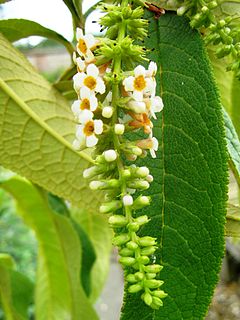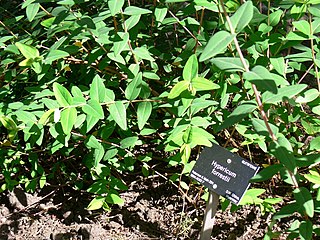
Pleione is a small genus of predominantly terrestrial but sometimes epiphytic or lithophytic, miniature orchids. This genus is named after Pleione, mother of the Pleiades, and comprises about 20 species. Common names of this genus include peacock orchid, glory of the east, Himalayan crocus, Indian crocus and windowsill orchid. The genus DiploconchiumSchauer is generally included here. Pleione is abbreviated to Pln in trade journals.

Pieris is a genus of seven species of shrubs in the family Ericaceae, native to mountain regions of eastern and southern Asia, eastern North America and Cuba. Known commonly in North America as andromedas or fetterbushes, they are broad-leaved evergreen shrubs growing to 1–6 metres tall and 3–10 ft (0.9–3.0 m) wide. The leaves are spirally arranged, often appearing to be in whorls at the end of each shoot with bare stretches of shoot below; they are lanceolate-ovate, 2–10 cm (0.8–3.9 in) long and 1.0–3.5 cm (0.4–1.4 in) broad, leathery textured, and with an entire or serrated margin. The young leaves in spring are typically brightly coloured. The flowers are bell-shaped, 5–15 mm (0.2–0.6 in) long, white or pink, and arranged in racemes 5–12 cm (2.0–4.7 in) long. The fruit is a woody capsule which splits into five sections to release the numerous small seeds.

Celosia argentea, commonly known as the plumed cockscomb or silver cock's comb, is a herbaceous plant of tropical origin, and is known for its very bright colors. In India and China it is known as a troublesome weed.

Juniperus squamata, the flaky juniper or Himalayan juniper, is a species of coniferous shrub in the cypress family Cupressaceae, native to the Himalayas and China

Magnolia sprengeri, or Sprenger's magnolia, is a species of Magnolia native to China, occurring in Gansu, Henan, Hubei, Hunan, Shaanxi, and Sichuan in forests or thickets at 1300–2400 m altitude. Named for Carl Ludwig Sprenger, a botanist of note.
The hybrid elm cultivar Ulmus × hollandica 'Cinerea' was first listed by George Lindley in 1815, as Ulmus cinerea, the Ash-coloured Elm, and later by the André Leroy Nurseries, Angers, France, in 1856. It was distributed as Ulmus cinerea by the Baudriller nursery, Angers, and as Ulmus montana cinerea by Louis van Houtte of Ghent. A specimen in cultivation at Kew in 1964 was found to be U. × hollandica, but the tree at Wakehurst Place remains listed as U. glabra 'Cinerea'.

Ficus pumila, commonly known as the creeping fig or climbing fig, is a species of flowering plant in the mulberry family, native to East Asia and naturalized in parts of the southeastern and south-central United States. It is also found in cultivation as a houseplant. The Latin specific epithet pumila means "dwarf", and refers to the very small leaves of the plant.

Mahonia oiwakensis is a species of plant in the barberry family, Berberidaceae. It is native to China and Myanmar, where it occurs at elevations of 600 to 3800 m. It has recently been found naturalized in South Africa.

Astilbe chinensis, commonly known as false goat's beard, tall false-buck's-beard or Chinese astilbe, is a plant in the saxifrage family, Saxifragaceae. It is commonly grown in shade gardens.

Symphyotrichum lateriflorum is a species of flowering plant of the aster family (Asteraceae) native to eastern and central North America. Commonly known as calico aster, starved aster, and white woodland aster, it is a perennial, herbaceous plant that may reach 120 centimeters high and 30 centimeters across. As composite flowers, each flower head has many tiny florets put together into what appear as one, as do all plants in the family Asteraceae.

Pieris japonica, the Japanese andromeda or Japanese pieris, is a species of flowering plant in the heath family Ericaceae. It is native to eastern China, Taiwan, and Japan, where it grows in mountain thickets. This medium-sized evergreen shrub or tree is widely cultivated in gardens.

George Forrest was a Scottish botanist, who became one of the first western explorers of China's then remote southwestern province of Yunnan, generally regarded as the most biodiverse province in the country.

Eriocapitella hupehensis, a species of flowering plant in the buttercup family Ranunculaceae, is native to Asia. The specific epithet hupehensis, which means "from Hupeh province, China", refers to a region where the species is known to occur. In Chinese, it is called da po wan hua hua, which means "broken bowl flower".

Buddleja forrestii is a deciduous shrub or small tree widely distributed from India to western China. First described by Diels in 1912, he named the species for plant hunter George Forrest, who discovered the plant in Yunnan in 1904 and introduced it to Western cultivation.

Linnaea chinensis, synonyms Abelia chinensis and Abelia rupestris, is a species of flowering plant in the honeysuckle family Caprifoliaceae. It was described by Robert Brown in 1818, and transferred to the genus Linnaea in 1872, although this move was not widely accepted until 2013. The plant inhabits China, Taiwan and Japan. It is a compact deciduous shrub with reddish stems and glossy, small leaves that become reddish-brown before autumn. It is one of the most cold-resistant species within the genus.

Hypericum forrestii is a species of flowering plant in the family Hypericaceae native to China and Myanmar. It is known as Forrest's tutsan and Forrest's St. John's wort. It was named in honour of the Scottish botanist George Forrest (1873-1932), who was the first westerner to discover it. The species has gained the Royal Horticultural Society's Award of Garden Merit.
Iris forrestii is a species of flowering plant in the genus Iris, also the subgenus Limniris and in the series Sibiricae. It is a rhizomatous herbaceous perennial, from China and Burma. It has linear grassy-like leaves, long thin stem and fragrant yellow or lemon-yellow flowers. It is cultivated as an ornamental plant in temperate regions.

Hypericum patulum, known as goldencup St. John's wort or yellow mosqueta, is a species of flowering plant in Hypericumsect. Ascyreia.

Eriocapitella is a genus of flowering plants in the buttercup family Ranunculaceae. Plants of the genus are native to Asia. The generic name Eriocapitella roughly translates to "growing in a small woolly head", which refers to the hairy ovary and fruit of some members of the genus. Cultivated plants are commonly known as fall-blooming anemones.
Eriocapitella japonica is a species of flowering plant in the buttercup family Ranunculaceae. The specific epithet japonica means "from Japan", which is a misnomer since the species is introduced in Japan. It is native to China, Taiwan, and Vietnam.

















